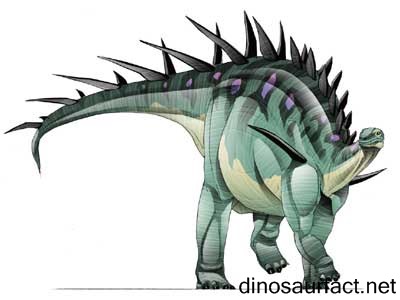 Click to visit the previous dinosaur bio
Click to visit the previous dinosaur bio
 |
|
 |
|
Kingdom: Animalia
Phylum: Chordata
Class: Sauropsida
SuperOrder: Dinosauria
Order: Ornithischia
SubOrder: Stegosauria
Family: Stegosauridae
Genus: Kentrosaurus
 |
|
 |
|
 |
|

In Greek language, Kentron means prickle or point and saurus means lizard. And thus the species here talked about derives its name as Kentrosaurus. It is an herbivorous in nature that used to draw itsr nutrition by eating plants and trees. It is a genus of stegosaurus dinosaur that lived in the late Jurassic period. The period between 156 million and 150 million years ago is considered as the late Jurassic period. These dinosaurs were believed to live in Africa. To be more specific they were primitives of late Jurassic of Tanzania in East Africa. This fact can be stated from the fact that their fossils and dead remains were found from Tendaguru Formation when extracted. The carbon dating of fossils also proved that they were dated to the Kimmerdigian stage that is in between 155.7+-4 million to 150.8+- million years ago.
It is true that Kentrosaurus is often related to Stegosaurus Dinosaur but it is quite different from it. The most obvious reason for the relation is that Kentrosaurus is also believed to be lived in the late Jurassic period as Stegosaurus. But if we compare their sizes then we can find out that Stegosaurus was 6 metres to 9 metres or 20 feet to 30 feet long whereas a Kentrsaurus at its most mature stage hardly was 4.9 metres or 16 feet long. Accordingly the weight of the Kentrosaurus was also significantly less than a Stegosaurus. A full grown Kentrosaurus weighed more or less around 2 tons.
Another interesting similarity is that Kentrosaurus had armor just like Stegosaurus. The armor was a useful defensive structure that protects the dinosaur from other predatory carnivorous dinosaurs like Allosaurus. However, the arrangement of its armor was different than the arrangement found in Stegosaurus. The armor arrangement in Stegosaurus includes bony plates along the back and tail and some spikes at the end of the tail. But Kentrosaurus had bony plates in pair only at the upper back and not along its lower back and tail. Its lower back and tail distinctly were covered with continuously running pairs of sharp spikes. These spikes were around 2 feet or 60 centimeters long and very pointed that perfectly served the purpose of protecting it against any danger from large predatory dinosaurs. In addition it had a pair of spikes on the hips as well.
The famous German expedition that took place in between 1909-1912 at East Africa first traced the pre existence of Kentrosaurus when its fossils and dead remains were discovered during the expedition. Later on in 1915 the well known paleontologist who was in the team of that famous German expedition, Edwin Henning, published the basic description of the animal for the first time. The skeleton extracted during that expedition was assembled and kept in the Humboldt Museum in the University of Berlin. Edwin Henning on the basis of that complete skeleton made his description about the Kentrosaurus. However, for unfortunate reason the skeleton is no longer in display in the Humboldt museum. The skeleton was completely destroyed by the atrocious allied bombing over Berlin during the World War II.
Index
Extinct Profiles
 Triassic Dinosaurs
Triassic Dinosaurs Jurassic Dinosaurs
Jurassic Dinosaurs Cretaceous Dinosaurs
Cretaceous Dinosaurs Pterosaurs
Pterosaurs Marine Reptiles
Marine Reptiles Dinosaur Extinction
Dinosaur Extinction